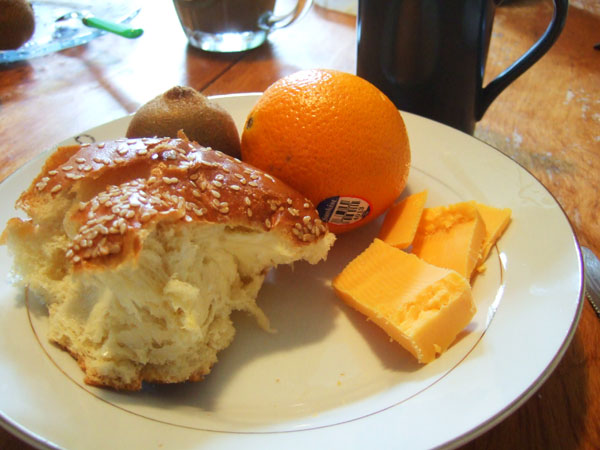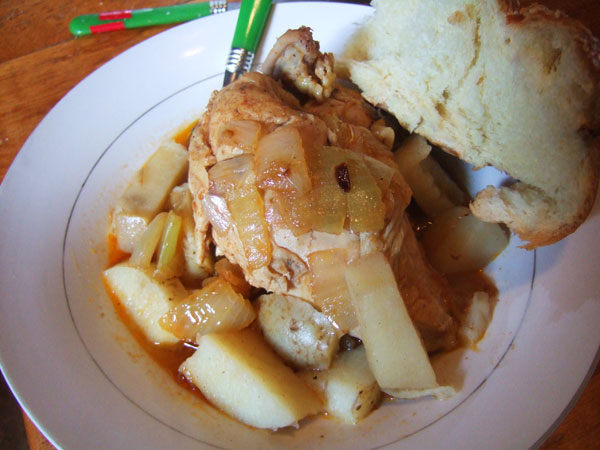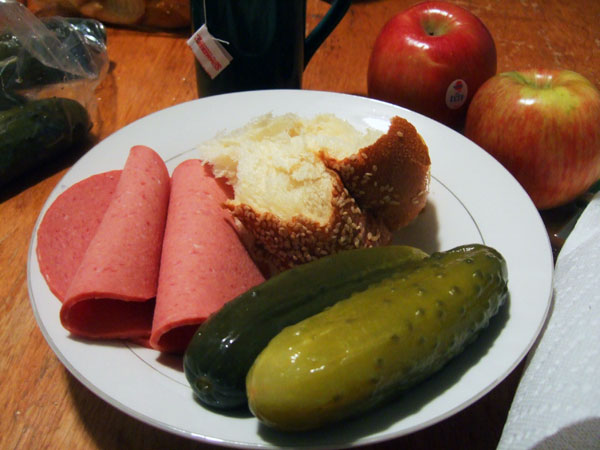 Breakfast: Bread & Butter, Cheese, Fruit, Coffee
Breakfast: Bread & Butter, Cheese, Fruit, Coffee
Breakfast
Fresh Fruit
American Cheese
Bread & Butter
Coffee
Dinner
Vegetable Soup
Pot Roast
Potatoes
Bread
Supper
Bologna
Dill Pickles
Stewed Fruit
Bread
Tea
While Boyfriend Brian made the coffee, I carefully got out the dairy dishes and silverware for breakfast. I realized that I had begun to like the ritual of choosing the dishes and setting them on the table; there was something very orderly and satisfying about it. We dug in to oranges, buttered bread, and hunks of cheddar cheese.
The cheese was more difficult to find than one would expect. We spent a solid fifteen minutes in the dairy aisle examing packages of American single slices. I don’t actually know what “American Cheese” would entail in 1914; was it the packaged cheese product that we know today? (I think I’ll be expanding this question into a full post on the origins of the grilled cheese sandwich). Most American cheese seems to be made with Rennet, an animal enzyme that makes Kraft Singles decidedly not kosher. In a fit of frustration, I grabbed a log of McCadam’s Cheddar Cheese and checked the back of the package: both Kosher and Hallal, and prominently marked. It was a suitable substitution.
 Chicken Fricassee: Tastes less beige than it looks.
Chicken Fricassee: Tastes less beige than it looks.
Lunch was vegetable soup from a can, both Kosher and Parve. I heated it and served it with half a bialy while I worked on the meat dish. I couldn’t find kosher beef at the store; instead, I had a sectioned chicken. To find a good recipe, I decided to turn to one of my standby cookbooks: The Settlement Cookbook: The Way to a Man’s Heart.
The Settlement Cookbook was published by a settlement house in Milwaukee, an organization run by the children and grandchildren of German Jewish immigrants who arrived in the mid-19th century. The turn of the century wave of Jewish immigrants from Eastern Europe struck these now “American” Jews as too foriegn, too orthodox, too strange; as a result, there was a huge movement to “Americanize” them. This book, a mix of midwestern American cuisine and traditional German Jewish fare, is one of the by-products.
I looked up the recipe for Chicken Fricasee, an American dinner table staple since sometime in the 18th century:
I didn’t have a red pepper on hand, so I threw a teaspoon of paprika in with the simmering onion, celery stalk and garlic clove. I salted and peppered two bone-in chicken breasts, and placed them skin side down in the hot pot. I let them brown, then covered the whole thing over with water. I added two bay leaves and a large, cubed potato before I covered the pot and let it simmer.
When the potatoes were tender, the chicken was done, too. It was really easy to throw together. In fact, everything I’ve cooked for lunch has been super simple but flavorful. I did *not* make the cream sauce the recipe suggests serving the chicken with.
Both Brian and I wanted juice to drink instead of water; while trying to determine if our carton of Tropicana was kosher, Brian came across OK Kosher Certification, a website that lets you search retail products to see if they have a kosher certification. This discovery is going to simplify this entire process.
The day came to an end with rolls of all-beef Hebrew National bologna, dill pickles from The Pickle Guys, and a bowl of hot stewed apples: Gala apples sliced and cooked slowly with water, raw sugar, and cinnamon.


